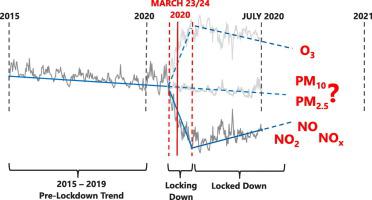Science of the Total Environment ( IF 9.8 ) Pub Date : 2020-09-16 , DOI: 10.1016/j.scitotenv.2020.142374 Karl Ropkins 1 , James E Tate 1

|
UK government implemented national lockdown in response to COVID-19 on the 23-26 March 2020. As elsewhere in Europe and Internationally, associated restrictions initially limited individual mobility and workplace activity to essential services and travel, and significant air quality benefits were widely anticipated. Here, break-point/segment methods are applied to air pollutant time-series from the first half of 2020 to provide an independent estimate of the timings of discrete changes in NO, NO2, NOx, O3, PM10 and PM2.5 time-series from Automatic Urban Rural Network (AURN) monitoring stations across the UK. NO, NO2 and NOx all exhibit abrupt decreases at the time the UK locked down of (on average) 7.6 to 17 μg.m-3 (or 32 to 50%) at Urban Traffic stations and 4 to 5.7 μg.m-3 (or 26 to 46%) at Urban Background stations. However, after the initial abrupt reduction, gradual increases were then observed through lockdown. This suggests that the return of vehicles to the road during early lockdown has already offset much of the air quality improvement seen when locking down (provisional estimate 50 to 70% by 01 July). While locking down O3 increased (7 to 7.4 μg.m-3 or 14 to 17% at Urban stations) broadly in line with NO2 reductions, but later changes suggest significant non-lockdown contributions to O3 during the months that followed. Increases of similar magnitudes were observed for both PM10 (5.9 to 6.3 μg.m-3) and PM2.5 (3.9 to 5.0 μg.m-3) at both Rural and Urban stations alike, but the distribution of changes suggests the lockdown was not an obvious direct source of changes in levels of either of these species during this period, and that more complex contributions, e.g. from resuspension and secondary aerosol, may be more likely major drivers for these changes.
中文翻译:

关于 COVID-19 封锁对英国空气质量趋势影响的早期观察
英国政府于 2020 年 3 月 23 日至 26 日针对 COVID-19 实施了全国封锁。与欧洲和国际其他地方一样,相关限制最初将个人流动性和工作场所活动限制在基本服务和旅行,人们普遍预计空气质量会显着改善。在此,将断点/分段方法应用于 2020 年上半年的空气污染物时间序列,以提供对 NO、NO 2、NO x、O 3、PM 10和 PM 2.5离散变化时间的独立估计来自英国各地自动城乡网络 (AURN) 监测站的时间序列。NO、NO 2和 NO x在英国锁定城市交通站(平均)7.6 至 17 μg.m -3(或 32 至 50%)和 4 至 5.7 μg.m -3(或 26 至 46% )时,所有都表现出突然下降) 在城市背景站。然而,在最初的突然减少之后,通过锁定观察到逐渐增加。这表明,在早期封锁期间车辆返回道路已经抵消了封锁期间空气质量的大部分改善(到 7 月 1 日临时估计为 50% 至 70%)。虽然锁定 O 3增加(7 至 7.4 μg.m -3或城市站点的 14 至 17%)与 NO 2减少大致一致,但后来的变化表明非锁定对 O 3的重要贡献在接下来的几个月里。PM 10(5.9 至 6.3 μg.m -3)和 PM 2.5(3.9 至 5.0 μg.m -3)在农村和城市站点都观察到类似幅度的增加,但变化的分布表明封锁是在此期间,这些物种中的任何一个的水平变化都不是明显的直接来源,并且更复杂的贡献,例如来自再悬浮和二次气溶胶,可能更有可能是这些变化的主要驱动因素。


























 京公网安备 11010802027423号
京公网安备 11010802027423号